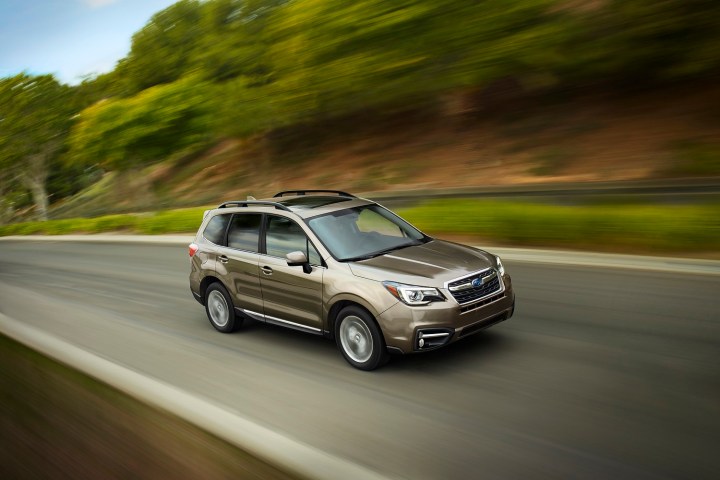
The company has expanded its EyeSight suite of electronic driving aids to include color cameras that provide a longer and wider field of vision. Steering-responsive headlights and automatic high beams are offered at an extra cost, and an available lane departure warning system helps keep the Forester in its lane.
EyeSight makes the Forester safer in reverse, too. Limited and Touring trim levels now come with a blind-spot detection system with rear cross-traffic alert, and the innovative reverse automatic braking technology inaugurated by the all-new 2017 Impreza that recently made its global debut at the New York Auto Show. The system warns the driver if it detects the car is about to hit an object while backing up, and hits the brakes if he or she doesn’t react in time.
The 2016 Forester’s engines carry over to the 2017 model, but Subaru has tweaked the continuously variable transmission (CVT) to boost gas mileage by two miles per gallon in the city and one mile per gallon in a combined cycle. The turbocharged 2.0XT Touring comes standard with a WRX STI-sourced active torque vectoring system that reduces understeer.
The tech updates for the 2017 model year are accompanied by a subtle facelift. Look closely and you’ll see that the Forester receives redesigned headlights with C-shaped LED daytime running lights inspired by the units found on recent Subaru concepts. The grille and the lower part of the front bumper have both been restyled, and the back end gets LED lights. Finally, a paint color called sepia bronze metallic joins the palette, while new 17- and 18-inch alloy wheels are available.
Inside, the most noteworthy upgrades are ones that can be heard, not seen. The cabin is much quieter than before thanks to the use of thicker glass, an acoustic windshield, more sound-deadening material, and additional underfloor insulation.
The 2017 Subaru Forester is scheduled to land in showrooms in the next few weeks. Pricing information will be published closer to the crossover’s on-sale date.
Editors' Recommendations
- Make tech work for you: 10 side gigs to make extra money for the new year
- 2022 Nissan Pathfinder first drive review: More tech, more toughness
- What the biggest tech companies are doing to make the 2020 election more secure
- 2021 Toyota RAV4 vs. 2021 Subaru Forester
- Volkswagen’s celebrated Golf GTI returns with more power and new tech




